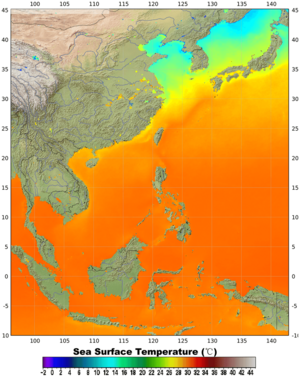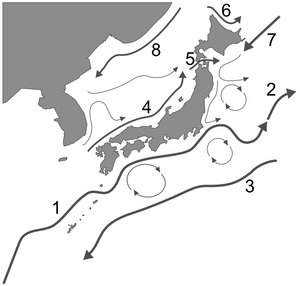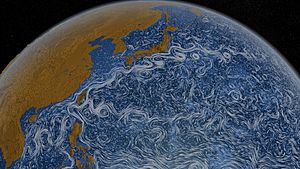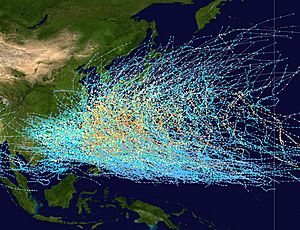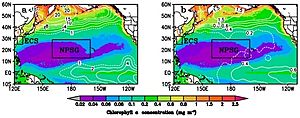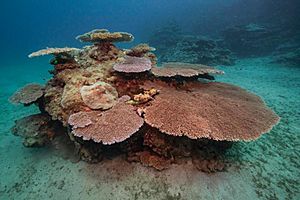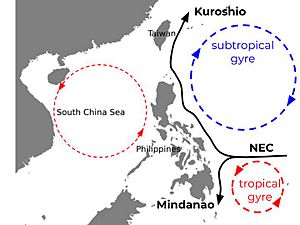Kuroshio Current facts for kids
The Kuroshio Current (黒潮), also known as the Black Stream or Japan Current, is a warm ocean current that flows north. It's found on the western side of the North Pacific Ocean. Its name comes from the deep blue color of its waters.
Think of the Kuroshio Current like a giant river in the ocean. It's similar to the Gulf Stream in the Atlantic Ocean. This powerful current carries warm water from near the equator towards the North Pole. It forms the western edge of the huge North Pacific Subtropical Gyre. Near Japan, it meets the Oyashio Current to create the North Pacific Current.
The Kuroshio Current is super important for the North Pacific Ocean. It moves nutrients and sediments, affects big storms, and influences the weather. Because it carries so many nutrients, it creates a rich ecoregion full of marine life. This supports a big fishing industry. For example, the South China Sea gets extra nutrients from the Kuroshio Current Intrusion, which helps sea life grow. Scientists are studying how the Kuroshio Current might get stronger due to climate change. This is different from the Gulf Stream, which is expected to slow down.
Contents
- What is the Kuroshio Current like?
- How does the Kuroshio Current move sand and dirt?
- What are ocean eddies?
- How does the Kuroshio Current transport nutrients?
- What marine life lives in the Kuroshio Current?
- How does the Kuroshio Current affect climate?
- How does the Kuroshio Current affect the economy?
- Images for kids
- See also
What is the Kuroshio Current like?
The Kuroshio is a warm ocean current. Its average surface temperature is about 24 °C (75 °F). It's usually around 100 kilometres (62 mi) wide. It often creates small to medium-sized swirling eddies.
The Kuroshio Current starts from the North Equatorial Current in the Pacific. This current splits near Luzon, Philippines. One part becomes the southward-flowing Mindanao Current. The other, larger part becomes the Kuroshio Current, flowing north.
East of Taiwan, the Kuroshio enters the Sea of Japan. It flows through a deep gap in the Ryukyu Islands called the Yonaguni Depression. It then follows the deepest part of the Sea of Japan, the Okinawa Trough. After that, it leaves the Sea of Japan through the Tokara Strait. It then flows along the southern coast of Japan, but its path can change a lot. Near the Bōsō Peninsula, the Kuroshio moves away from Japan and heads east. This part is called the Kuroshio Extension.
The Kuroshio Current is like the Gulf Stream in the Atlantic Ocean. Both currents carry warm, tropical water towards the polar regions. The warm waters of the Kuroshio Current help support the coral reefs of Japan. These are the northernmost coral reefs in the world! A part of the Kuroshio that goes into the Sea of Japan is called the Tsushima Current (対馬海流, Tsushima Kairyū).
Just like the Gulf Stream, the Kuroshio Current makes the ocean surface warm. It also adds a lot of moisture to the air over the western Pacific. This helps create and keep tropical cyclones going. Tropical cyclones, also known as typhoons, form when the atmosphere is unstable, the ocean surface is warm, and there's lots of moist air.
The Western North Pacific Ocean gets about 25 typhoons each year. Most typhoons happen from July to October, during the northern hemisphere summer. They usually form where the Kuroshio Current is warmest, near the equator. Typhoons tend to follow the current's warm water poleward until they reach colder waters and fade away.
The strength of the Kuroshio Current changes along its path and with the seasons. In the Sea of Japan, it flows at about 25Sv (25 million cubic meters per second). When it re-enters the Pacific Ocean, it gets much stronger. It can reach 65Sv (65 million cubic meters per second) southeast of Japan. This strength also changes a lot with the seasons.
How does the Kuroshio Current move sand and dirt?
The strong flow of the Kuroshio Current and the shape of the seafloor cause deep-sea erosion and sediment transport. This means it moves sand and dirt around.
For example, off Southern Taiwan, the current speeds up. This causes erosion, revealing areas like the Kuroshio Knoll. The size of sand grains on the Kenting Plateau shows how the current erodes the area. Deeper down, the grains are larger because smaller ones are swept away. Some fine sand settles into dunes, while the rest is carried away by the current.
The Kuroshio Current also moves sediment from the Yangtze River. How much sediment moves depends on how the Kuroshio Current interacts with the China Coastal Current and the Taiwan Warm Current. Because of these interactions, Yangtze River sediment settles on the East China Sea inner shelf instead of going into the deep sea.
Scientists can track where sediments come from by looking at their unique elements. For example, Taiwanese sediment has illite and chlorite. These have been found all the way through the Kuroshio Current into the South China Sea. This helps scientists understand how the current moves materials.
What are ocean eddies?
Eddies are like giant whirlpools in the ocean. They help fish larvae survive and grow as they are carried by the Kuroshio. The amount of Plankton (tiny plants and animals) is usually highest in the eddy areas near the Kuroshio's edge.
Warm-core rings are a type of eddy. They are not usually known for having lots of life. However, studies show that biological life is spread evenly throughout the Kuroshio's warm-core rings. This is because of upwelling (when deep, nutrient-rich water rises) at the edges and mixing as the rings move north and cool down. This mixing brings nutrients to the surface, causing tiny ocean plants to grow rapidly.
Typhoons can create very strong winds. These winds push on the ocean's surface, mixing the warmer top layer with the cooler, deeper water. This mixing brings nutrients from the deep water to the surface. Tiny organisms like phytoplankton and algae use these new nutrients to grow. For example, in 2003, two typhoons caused a lot of mixing. This led to two big algal blooms in the North Western Pacific Ocean, which affected Japan.
How does the Kuroshio Current transport nutrients?
The Kuroshio Current is like a "nutrient stream." It carries a lot of nutrients from the East China Sea to the subarctic Pacific Ocean. These nutrients support high rates of primary production (how much new life is created). The current's water is rich in nutrients, even when surrounded by water of the same density that has fewer nutrients.
Nutrients are brought to the surface when the Kuroshio Current flows over shallow areas and underwater mountains. This happens over the Okinawa Trough and the Tokara Strait. The Tokara Strait also has a lot of swirling activity. This, combined with the Coriolis Effect, causes strong upwelling along the continental shelf. This upwelling is vital for tiny ocean plants (phytoplankton). They need to stay in the upper layers where sunlight is available for photosynthesis. The constant flow of nutrient-rich water to sunny areas helps these plants grow, supporting the entire diverse ecosystem of the Kuroshio Current.
What marine life lives in the Kuroshio Current?
The Kuroshio Current carries nutrients, heat, and tiny organisms (plankton). It also flows through many different water bodies. This creates a very high number of different species in and around the current. The Kuroshio is considered a biodiversity hotspot. This means it has many different species, but many are at risk due to human activities like overfishing.
Tiny Ocean Plants (Photoautotrophs)
Phytoplankton
Phytoplankton are tiny plants that float in the ocean. They are responsible for the high rates of primary production in the current. The warm, clear waters of the Kuroshio allow sunlight to go deeper. This helps certain cyanobacteria like Prochlorococcus and Synechococcus to thrive. These two species might be responsible for half of the carbon dioxide (CO2) taken in by plants in the Kuroshio Current's sunny zone.
Dust storms from the Gobi desert in Asia also bring dust to this region. This dust contains nutrients like phosphate and metals. These nutrients help Prochlorococcus, Synechococcus, and diatoms grow.
Diatoms and Trichodesmium are important for moving nitrogen and carbon in and out of the ocean's sunny zone. Trichodesmium helps with nitrogen fixation, which provides a key nutrient (nitrate) for other plants to grow. Diatoms, with their heavy "glass houses" made of silica, help move carbon and nitrogen out of the sunny zone when they sink.
Seaweed (Macro-flora)
At least ten types of seaweed live in and around the Kuroshio Current. Caulerpa, a green algae, grows thickly near the shore. Brown algae and red algae also grow well here. Like other plants, they benefit from the nutrient transport and clear waters of the region.
Ocean Animals Without Backbones (Invertebrates)
Zooplankton
Zooplankton are tiny animals that drift in the ocean. Their numbers increase in the cooler waters of upwelling sites within the Kuroshio Current. This is because upwelling brings up lots of phytoplankton, which zooplankton eat.
The Kuroshio Current's flow through the Luzon Strait and South China Sea, along with summer monsoons, creates areas where different ocean waters meet and mix. This mixing greatly influences where many zooplankton species are found. It makes zooplankton communities more nutritious, unique, and diverse.
Many types of fish larvae are also found in zooplankton communities carried by the current. Fish larvae are an important part of the Kuroshio Current's food chain. For example, baleen whales eat Japanese sardine and jack mackerel larvae that are carried to their feeding grounds. Climate change is affecting where fish larvae are found. This can impact fish migration, fish populations, and major fisheries.
Coral
The coral reefs in the Kuroshio Current live further north than any other tropical reef in the world (at 33.48°N). An important reef-building coral here, Heliopora coerulea, is threatened. This is due to warming ocean temperatures from climate change, ocean acidification from pollution, and dynamite fishing.
Acropora japonica, Acropora secale, and Acropora hyacinthus are three more reef-building corals in the area. These corals have special relationships with tiny algae called zooxanthellae, which help them get nutrients.
These corals also face threats from predators like the Crown-of-thorns starfish and a sea snail called Drupella fragum. The Crown-of-thorns starfish eats corals. If its population explodes, it can cause huge damage to entire coral communities. This, combined with human threats, can cause irreversible damage to reefs.
The Kuroshio Current helps connect coral reefs. It carries coral larvae from southern reefs to other reefs along the Ryukyu Arc.
Squid
Western boundary currents like the Kuroshio are used by some squid species for fast and easy travel. This allows adult squid to reach rich feeding grounds in the north without using much energy. Their eggs and young develop in the warm current waters during winter.
The Japanese flying squid (Todarodes pacificus) has three groups that breed in different seasons. The winter group breeds in the East China Sea. Their larvae and young travel north with the Kuroshio Current. They are then caught near the islands of Honshu and Hokkaido in the summer.
Ocean Animals with Backbones (Vertebrates)
Fish

The Kuroshio Current is home to thousands of fish species. This is because of the rich nutrients and diverse waters. The warmer ocean conditions lead to a lot of tiny plants and animals, which then support larger fish. Fish found here include reef fish like rabbitfish and parrotfish, open-ocean fish like sardines, anchovies, mackerel, and sailfish, and top predators like sharks.
Fishing is a big industry in this area. It depends a lot on the changing ocean conditions, which are largely controlled by the Kuroshio Current. To the north, the Oyashio Current brings much colder water. Where these two currents meet is called the Kuroshio-Oyashio region. The conditions here change throughout the year, affecting which fish species are present and how successful fishing is. For example, when the Oyashio current is strong, it brings cold waters that are good for catching sardines.
Sea Turtles
Five out of the seven types of sea turtles use the Kuroshio Current to reach warm waters. These include loggerheads (Caretta caretta), green (Chelonia mydas), hawksbill (Eretmochelys imbricata), leatherbacks (Dermochelys coriacea), and Olive ridleys (Lepidochelys olivacea).
Female sea turtles use the current to get to the warm nesting beaches of Japan. Young green and hawksbill turtles use the current to reach waters around Japan.
Marine Mammals
Marine mammals like seals, sea lions, and cetaceans (whales and dolphins) also use the Kuroshio Current's rich waters. Dolphins found here include the Spinner dolphin (Stenella longirostris), short-finned pilot whale (Globicephala macrorhynchus), common bottlenose dolphin (Tursiops truncatus), Dall's porpoise (Phocoenoides dalli), Risso's dolphin (Grampus griseus), and the Killer whale (Orcinus orca).
Three types of whales also use this area for feeding: the Common Minke (Balaenoptera acutorostrata), the Sei Whale (Balaenoptera borealis), and Bryde's Whale (Balaenoptera edeni). Their main food sources are Japanese sardines and mackerel eggs, larvae, and young fish.
How does the Kuroshio Current affect climate?
The Kuroshio Current is a key part of the world's climate. It brings warm water from lower latitudes northward into the western Pacific. This greatly influences regional climate and weather patterns.
The Kuroshio Current, like other western boundary currents, changes with the seasons. Its flow rates, where it splits, and water saltiness all vary. This movement of warm, salty water north along the western Pacific shapes the western edge of the North Pacific Gyre.
The exchange of heat from the ocean surface to the atmosphere in this area is one of the largest in the entire Pacific. This is especially true in winter. When the ocean transfers heat to the atmosphere, it creates unstable air conditions. This means the air becomes warmer than the surrounding air, rises, and increases the chance of rain or changes in weather. This is why monsoon rains are common in summer, and typhoons get stronger as they pass over the current. The climate of many Asian countries has been affected by this heat distribution for millions of years. It changes wind patterns, rainfall, and mixes warm tropical waters into the Sea of Japan.
How does climate change affect the Kuroshio Current?
Scientists predict that climate change, especially rising sea surface temperatures, will make the Kuroshio Current stronger. This is also expected for other western boundary currents in the Pacific. The effects of warming oceans might be different in the Atlantic and Pacific. The Atlantic's main current system is predicted to slow down, while the Pacific's western currents, including the Kuroshio, may get stronger.
These changes are thought to be caused by changes in wind stress and surface warming. This leads to more layers in the ocean's surface waters. Specifically, winds are predicted to shift towards the poles. This could make the subtropical gyre's wind stress stronger, leading to a stronger Kuroshio Current. Some predictions suggest its flow speed could almost double. The entire current is expected to strengthen, from where it splits near the equator to its extension.
Scientists use historical data and ocean models to make these predictions. Models also suggest that as the surface layer strengthens, the deeper layer of the Kuroshio Current might slow down. The exact reasons for this are still being studied.
How does the Kuroshio Current affect the economy?

The Kuroshio Current can be helpful for shipping. Ships traveling with the current can save time and fuel. However, ships going against the current will use more time and fuel.
The Kuroshio supports many important fisheries. Jack Mackerel are a very important fish for Japan, Korea, and Taiwan. As the Kuroshio flows northeast from Taiwan, it carries Jack Mackerel eggs and larvae to southern Japan. These young fish are then caught and raised in fish farms. Other important fish caught here include pollock, sardine, and anchovy.
Many port cities are developing along the Kuroshio Current. The area where the Kuroshio meets the Oyashio current has historically been known for fishing. However, this region is still recovering from the Fukushima Daiichi Nuclear Power Plant accident in 2011.
In 2011, a huge earthquake caused a devastating tsunami. This tsunami flooded over 200 miles of Japan's coast. It also caused a nuclear disaster at the Fukushima nuclear plant. This released radioactive materials into the ocean. While local waters were most affected, this material was carried across the entire North Pacific Ocean by the North Pacific Current.
Local fisheries lost over 90% of their boats and couldn't fish for up to a year. The local economy is working to recover, but fishing catches are still not back to pre-accident levels. No fishing is allowed within 10 km of the accident site. Catches outside that zone are checked for radioactive materials, which costs fisheries time and money. By 2014, most of the port and fish farming facilities in Minamisanriku were restored. By 2018, key infrastructure in the Japanese Prefectures of Iwate and Miyagi was almost rebuilt. In 2021, local Japanese fishing fleets caught 5,928 tons of seafood, valued at over 2.21 billion yen (19.342 million U.S. dollars).
Changes in the Kuroshio Current and its warming conditions have also affected pilot whale migration. These animals are considered a special food, but hunting is strictly controlled. Changes in their migration timing affect local hunters who depend on them. Management plans need to protect these animals and consider the economic impact on local hunters.
Images for kids
-
The Oyashio Current colliding with the Kuroshio Current near Hokkaido. When two currents meet, they create eddies. Phytoplankton grow in the surface waters and become concentrated along the edges of these eddies, showing how the water moves.
See also
 In Spanish: Corriente de Kuroshio para niños
In Spanish: Corriente de Kuroshio para niños



